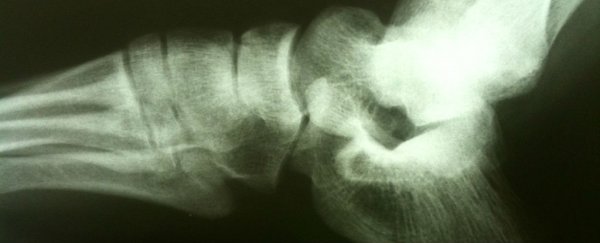Researchers have collected stem cells from human amniotic fluid - the protective fluid that surrounds the baby in the uterus - and used them to treat mice with brittle bone disease.
The treatment resulted in 79 percent fewer fractures by actively increasing the strength, plasticity, and structure of the animals' bones, and now the team is investigating if it will work in humans - particularly astronauts, who can lose 2.5 percent of their bone density for every month in space.
"We could inject these factors into older people, or into astronauts, to give bone forming cells a boost," lead researcher Pascale Guillot from University College London told The Guardian.
"The stem cells we've used are excellent at protecting bones. The bones become much stronger and the way the bone is organised internally is of much higher quality."
Guillot and her team sourced human amniotic fluid from healthy, pregnant donors during screening tests at the 12-week mark, or just before birth.
From this fluid, they extracted human amniotic fluid mesenchymal stem cells (AFSCs), and injected them into mice so they could infuse in their bones.
The mice were bred to develop brittle bone disease - a genetic disorder that results in fragile bones that break easily, mirroring the effects of mineral loss from ageing.
The disease is similar to osteoporosis - a common problem, especially for older women, where the bones become brittle and fragile from loss of tissue - so it's a good model for age-related bone degradation.
Eight weeks after the stem cell infusion, the instances of fractures in femur, tibia, and humorous bones were assessed in the 168 treated and 156 control mice.
While 100 percent of control mice showed at least one bone fracture, the fracture incidence in the treated mice was reduced by 69 percent in humorous bones, 89 percent in femurs, and 79 percent in tibias.
Across the three types of bones, the team found a 79 percent decrease in fracture rate in the treated mice.
The bones were also subjected to bending tests, and had their structure and composition analysed.
As Ian Sample reports for The Guardian, the stem cell infusions weren't prompting the formation of fresh bones, but instead released growth factors that made the existing bone cells in the mice multiply and mature more effectively.
The team says that while human foetal tissue stem cells - extracted from umbilical cords - have been shown to reduce bone fracture rates in mouse models before, transplantation has failed to improve bone strength, and only increased the plasticity of the bone.
Stem cells derived from amniotic fluid, on the other hand, have now been shown to improve strength, plasticity, and structure - and amniotic fluid, the stuff that comes out when a woman's 'water breaks', comes with far fewer immune response problems.
"Here we have established for the first time that human AFSCs can be used as [a] countermeasure to bone fragility," the team concludes in their paper.
Of course, nothing's certain until the results can be replicated in humans, so the team is planning to start a clinical trial within the next two years.
"We are already used to putting cream on our face to slow down ageing of the skin, this will be the same for the skeleton," Guillot told James Gallagher at BBC News.
"I think in the next few years, we will have ways to slow down the ageing of our skeleton to reduce fractures and pain. This will also be very important for space travel, as when you don't have G-force the bones become fragile."
The research has been published in Scientific Reports.
